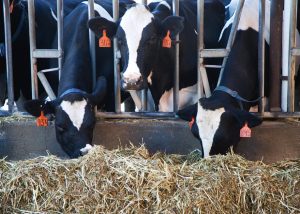Alvaro D. Garcia
Introduction
Much research has concentrated on the effects of starch on the rumen microbial population (both positive and negative). Recent research3 however, showed that the fiber to starch ratio in the diet, also affected the growth of the rumen papillae in lactating dairy cows. This is significant since these tiny structures determine how much energy the cow obtains from feed fermentation. This study found that as the fiber to starch ratio increased, the expression of the gene regulating the growth of papillae decreased. We oftentimes state there are no requirements for starch, a seemingly accurate assertion based on our present body of knowledge. Too little starch in the diet however, and the papillae growth will be inadequate to maximize the absorption of volatile fatty acids (and thus energy). The right amount of starch thus determines the cow’s absorption precursors for energy (for which there are requirements!).
On the other hand, too much starch in the diet reduces forage digestibility, and increases the incidence of digestive upsets. The fact that science has not yet been able to determine starch requirements in high lactating cows, does not mean they do not exist!. It is safe to assume however that cows fed high amounts of well-eared corn silage have their starch needs met. Not only because of the corn grain in the silage, but also because it is more degradable than dry-shelled corn.
Starch supply
Let us assume the main starch sources in a given dairy cow diet are 8 kg of corn silage and 7 kg of shelled corn dry basis. Using the equation proposed by Lauer and Undersander2, we can calculate the corn grain per ton of silage. Assuming a yield of 25 tons of silage (as is) per acre or 8.75 tons of dry matter (DM), the grain yield will be:
Corn grain yield (bushels/acre) = (42.3*tons of silage DM) – (1.53*(tons of silage DM2) – 72.7
[180.28 bushels or 4589 kg of corn grain/acre = (42.3 x 8.75) – (1.53 x (8.75)2) – 72.7]
Each kg of corn silage will contain 0.57 kg of corn, 8 kg of corn silage fed, will supply nearly 4.5 kg of grain, which added to the 7 kg of shelled corn, totals 11.5 kg of corn grain. In the not so distant past, corn for grain varieties had approximately 60 percent starch. This particular diet would have supplied then approximately 7 kg of starch. Today’s corn hybrids however, contain approximately 70-74 percent starch, driven particularly by the needs of the US ethanol industry. That very same diet could easily contain nowadays 8.5 kg of starch or nearly 20 percent more. The conclusion is that modern corn hybrids are “hotter” than in the past, and there needs to be more precision and care when fed at higher concentrations.
Dairy cows however can digest relatively large amounts of starch particularly if the sole source is not just dried shelled corn. Work of Firkins et al.1 suggested cow’s digestion of corn starch in the rumen ranges from a low of roughly 45 percent for dry cracked shelled corn, to a high of approximately 87% for high moisture rolled corn (HMC). As mentioned above this can be also highly variable depending on how fast the feed transits through the rumen (particle size and level of intake). Other factors that affect the degree of degradability are prolamin (zein) content, degree of processing, and rate of passage. In the work of Firkins1 the starch digestibility in the total tract was 85 and 94 percent for cracked and HMC, respectively.
Starch digestibility
The total tract digestibility of the starch in corn silage is very similar to that of HMC, and even slightly higher, at 99 percent1. For the sake of simplicity, let us assume they are both 94 percent. Based on these figures and the dietary starch estimations above, modern cows fed dry corn and corn silage could degrade in the rumen 5.7 kg of starch. Cows fed corn silage and HMC could degrade 7.7 kg of starch in the rumen, or roughly 35 percent more.
When the source of starch in dairy cow diets was exclusively dry ground corn, partially switching it with HMC (degradable rumen energy), we could predict almost with absolute certainty an increase in milk protein in just a few days! This resulted from increased microbial production, consequence of the higher rumen fermentable energy, which ended in more microbial protein supply to the intestines. The results of Ma et al.3 suggest that given a little more time this would also result in the development of more area of absorption (papillae). This matches increased energy available in the rumen with greater intestinal protein availability, promoting greater milk production. We have come full-circle to conclude that ideal starch concentrations (requirements) will also increase protein/energy availability and will sustain higher milk production.
Once in the intestines, the work of Firkins et al. showed a degree of compensation between the total tract starch digestibility of dry corn and HMC corn. The total tract digestibility of dry cracked corn was 85 percent, which means that of the 8 kg in the diet approximately 1.2 kg ended in the feces. The question is if this relatively high fecal loss is unavoidable, and is the result of insufficient intestinal amylases incapable of digesting the starch mostly from cracked dry corn. In this circumstance, the content of prolamin, which encapsulates starch granules in the endosperm, certainly plays a significant role.
When applied to the HMC diet the results seem to confirm this. The total starch tract digestibility of the HMC (including corn silage) was 94 percent, which means that of 8 kg of starch in the diet, 0.48 kg ends in the feces. Since there was also 0.5 kg left after rumen degradation, it is clear that what ends in the feces was what neither rumen microbes nor intestine enzymes can degrade any further. Feeding HMC is without a doubt the most efficient utilization of starch by the high production dairy cow.
Applications
From the iterations above it is obvious that many things affect starch requirements, but it seems grain maturity and moisture content are likely the most important. In today’s world, everything is about environment, optimization, and rational use of land resources. It might be possible that starch requirements for dairy cows need determinations based on certain “standard”, which rather than dry shelled corn could very well be the starch dry matter in corn silage kernels or in high moisture corn. We do know today that dairy cow’s pancreatic α-amylase exhibits fluctuations in secretion depending on the diet. It seems that energy intake is important resulting in increased microbial flow, which stimulates α-amylase and enhances the morphological papillae development, necessary to enhance VFA absorption.
From the discussion above, the balance between fermentable energy (and subsequent rumen microbial protein) plays a major role. It leads to increased α-amylase production, and starch (glucose) availability, which in turn decreases α-amylase production and secretion. One way or the other there are challenges ahead that need holistic approaches involving the cows and their environment if we are to determine their starch requirements.
About the author
Alvaro D. Garcia is a tenured Professor of Dairy and Food Sciences at South Dakota State University as well as the SDSU Extension Director of Agriculture and Natural Resources. He has traveled the world helping farmers in more than 20 countries. He has written more than 500 technical articles, three book chapters, and presented in conferences worldwide. He currently reviews and edits all SDSU Extension ANR pieces published yearly.
References
- Firkins, J.L., M.L. Eastridge, N.R. St-Pierre, and S.M. Noftsger. 2001. Effects of grain variability and processing on starch utilization by lactating dairy cattle. J. Anim. Sci. 79 (E. Suppl.): E218-E238.
- Lauer, J. and D. Undersander. 2004. “Pricing corn silage for sale.” In Proceedings and Joint Meeting of the Professional Nutrient Applicators of Wisconsin, Wisconsin Custom Operators, and Wisconsin Forage Council. Eau Claire, WI. p. 87-91 (invited).
- Ma L., M. Zhao, L. S. Zhao, J. C. Xu, J. J. Loor, and D. P. Bu. 2017. Effects of dietary neutral detergent fiber and starch ratio on rumen epithelial cell morphological structure and gene expression in dairy cows. Journal of Dairy Science. 100: 3705-3712.









